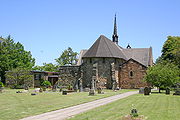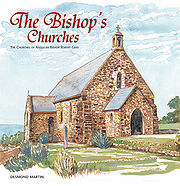
Sophy Gray
Encyclopedia

Equestrianism
Equestrianism more often known as riding, horseback riding or horse riding refers to the skill of riding, driving, or vaulting with horses...
and the wife of Cape Town
Cape Town
Cape Town is the second-most populous city in South Africa, and the provincial capital and primate city of the Western Cape. As the seat of the National Parliament, it is also the legislative capital of the country. It forms part of the City of Cape Town metropolitan municipality...
bishop Robert Gray
Robert Gray (bishop)
Robert Gray was the first Anglican Bishop of Cape Town.-Biography:Gray was born in Bishopwearmouth, north east England, the son of Robert Gray, Bishop of Bristol, who ordained him deacon in Wells Cathedral on 11 January 1834. His first parish was at Whitworth. In 1845 he became the vicar of...
. Born 5 January 1814 at Easington in Yorkshire
Yorkshire
Yorkshire is a historic county of northern England and the largest in the United Kingdom. Because of its great size in comparison to other English counties, functions have been increasingly undertaken over time by its subdivisions, which have also been subject to periodic reform...
, the 5th daughter of county squire Richard Wharton Myddleton of Durham
Durham
Durham is a city in north east England. It is within the County Durham local government district, and is the county town of the larger ceremonial county...
and Yorkshire, she died at Bishopscourt, Cape Town
Bishopscourt, Cape Town
Bishopscourt is a small, wealthy, residential suburb in the Southern Suburbs of Cape Town in the Western Cape, South Africa. It is part of the Cape Town Metropolitan Municipality, created in 2000, which includes the greater Cape Town area. It has approximately 350 houses most of which reside on...
on 27 April 1871 and was buried in the graveyard of St Saviour's in Claremont. E. Hermitage Day wrote "the constant companion of (Robert Gray's) travels, the untiring amanuensis and accountant, the skilful designer of churches, the brightness and stay of his home life at Bishopscourt."
England
Sophy and her two sisters were raised in an affluent family, owning estates in North RidingNorth Riding of Yorkshire
The North Riding of Yorkshire was one of the three historic subdivisions of the English county of Yorkshire, alongside the East and West Ridings. From the Restoration it was used as a Lieutenancy area. The three ridings were treated as three counties for many purposes, such as having separate...
and Durham. They were well-read and proficient riders from an early age, qualities that helped foster their friendship with the young Robert Gray. Sophy married Robert Gray in 1836 after a six-month engagement, when he was rector of Whitworth, Durham. Their honeymoon gave young Sophy a taste of things to come when she and Robert set out on a lengthy horseback trip, visiting the family holdings in two counties. For nine years their lives at Old Park and Whitworth, and the urban parish of Stockton remained fairly untroubled, but all this changed dramatically when Robert was placed on a shortlist for one of three new colonial bishoprics. He was chosen for the Cape of Good Hope
Cape of Good Hope
The Cape of Good Hope is a rocky headland on the Atlantic coast of the Cape Peninsula, South Africa.There is a misconception that the Cape of Good Hope is the southern tip of Africa, because it was once believed to be the dividing point between the Atlantic and Indian Oceans. In fact, the...
.
South Africa
In 1847 Sophy and Robert travelled to Cape Town where he was to establish a new colonial diocese, increase the number of clergy and establish new churches and schools. There were only ten Anglican churches in South Africa at that time. With his death 25 years later, this number had risen to 63. Having grown accustomed to the high standard of living enjoyed by bishops, including an episcopal palace, the Grays emigrated to the Cape with a retinue of servants, furniture and even an episcopal carriage.The couple settled on the farm Boschheuvel, originally named Wijnberg and later renamed Bishopscourt, the original owner having been Jan van Riebeek, first Dutch Governor of the Cape. The farm lay on the slopes of Table Mountain
Table Mountain
Table Mountain is a flat-topped mountain forming a prominent landmark overlooking the city of Cape Town in South Africa, and is featured in the flag of Cape Town and other local government insignia. It is a significant tourist attraction, with many visitors using the cableway or hiking to the top...
, well-watered and with dense woodland. Here Sophy, using the old slave quarters, started a school for her five children and those of the community. Despite disliking social engagements, she kept open house to a constant stream of church officials and dignitaries, as well as managing Robert's diocese that included the Cape
Cape
Cape can be used to describe any sleeveless outer garment, such as a poncho, but usually it is a long garment that covers only the back half of the wearer, fastening around the neck. They were common in medieval Europe, especially when combined with a hood in the chaperon, and have had periodic...
, Orange Free State
Orange Free State
The Orange Free State was an independent Boer republic in southern Africa during the second half of the 19th century, and later a British colony and a province of the Union of South Africa. It is the historical precursor to the present-day Free State province...
, Natal
Colony of Natal
The Colony of Natal was a British colony in south-eastern Africa. It was proclaimed a British colony on May 4, 1843 after the British government had annexed the Boer Republic of Natalia, and on 31 May 1910 combined with three other colonies to form the Union of South Africa, as one of its...
and the islands of Tristan da Cunha
Tristan da Cunha
Tristan da Cunha is a remote volcanic group of islands in the south Atlantic Ocean and the main island of that group. It is the most remote inhabited archipelago in the world, lying from the nearest land, South Africa, and from South America...
and St. Helena.
Sophy Gray had brought along architectural plans of churches that could be adapted to the design of churches and schools for the new Anglican parishes that were to be established throughout South Africa. Both Sophy and her husband favoured the neo-Gothic style of church architecture which was fashionable in Britain at that time and advocated by the Ecclesiologists, and disliked the Romanesque style. Even so, Sophy and Robert Gray felt that church design should not stick slavishly to the Early English Period, but should show some diversity.
She not only filled the role of architect, but kept records of the synods, their meetings and official ceremonies. She also kept records of correspondence and church chronicles. Being a competent horsewoman, she joined her husband on all but two of his extended trips. Her artistic skills were shown by the numerous water-colours and sketches she did, frequently used to illustrate her husband's journals. In all, the bishop would hardly have managed without her able assistance and knowledge. As if in recognition of her contribution, there is a stained glass window in St George’s Cathedral, depicting her wearing a green riding habit and bonnet, though usually she wore a felt hat and plain riding dress, beneath which were close-fitting riding breeches of chamois.

Rondebosch
Rondebosch is one of the Southern Suburbs of Cape Town, South Africa. It is primarily a residential suburb, with a medium-size shopping area, a small business district as well as the main campus of the University of Cape Town.-History:...
, St Saviour's, Claremont
Claremont, Cape Town
Claremont is a suburb of Cape Town, South Africa. It is situated six miles south of the city, and is one of the so-called "Southern Suburbs". It is an important commercial and residential area, which is currently experiencing significant growth and development.-History:Until the arrival of Dutch...
, St Peter's, Plettenberg Bay
Plettenberg Bay
Plettenberg Bay, nicknamed Plet or Plett, is the primary town of the Bitou Local Municipality in the Western Cape Province of South Africa. As of the census of 2001, there were 29149 population...
, St James, Graaff-Reinet and St Jude's, Oudtshoorn.
Churches designed by Sophy Gray
|
Grahamstown Grahamstown is a city in the Eastern Cape Province of the Republic of South Africa and is the seat of the Makana municipality. The population of greater Grahamstown, as of 2003, was 124,758. The population of the surrounding areas, including the actual city was 41,799 of which 77.4% were black,... 1856 Cradock, Eastern Cape Cradock is a town in the Eastern Cape Province of South Africa, in the upper valley of the Great Fish River, by rail northeast of Port Elizabeth. The town is the administrative seat of the Inxuba Yethemba Local Municipality in the Chris Hani District of the Eastern Cape. The estimated population... 1857 Cape Town Cape Town is the second-most populous city in South Africa, and the provincial capital and primate city of the Western Cape. As the seat of the National Parliament, it is also the legislative capital of the country. It forms part of the City of Cape Town metropolitan municipality... 1859 Bredasdorp Bredasdorp is a town in the Southern Overberg region of the Western Cape, South Africa, and the main economic and service hub of that region. It lies on the northern edge of the Agulhas Plain, about south-east of Cape Town and north of Cape Agulhas, the southernmost tip of Africa.-History:The... 1859 Ceres, Western Cape Ceres is a town with 46,251 inhabitants in the Western Cape Province of South Africa. It is the administrative centre and largest town of the Witzenberg Local Municipality. Ceres serves as a regional centre for the surrounding towns of Wolseley, Tulbagh, Op-die-Berg and Prince Alfred Hamlet... 1860 Cape Town Cape Town is the second-most populous city in South Africa, and the provincial capital and primate city of the Western Cape. As the seat of the National Parliament, it is also the legislative capital of the country. It forms part of the City of Cape Town metropolitan municipality... 1860 Rondebosch Rondebosch is one of the Southern Suburbs of Cape Town, South Africa. It is primarily a residential suburb, with a medium-size shopping area, a small business district as well as the main campus of the University of Cape Town.-History:... , Cape Town Cape Town Cape Town is the second-most populous city in South Africa, and the provincial capital and primate city of the Western Cape. As the seat of the National Parliament, it is also the legislative capital of the country. It forms part of the City of Cape Town metropolitan municipality... 1864 Cape Town Cape Town is the second-most populous city in South Africa, and the provincial capital and primate city of the Western Cape. As the seat of the National Parliament, it is also the legislative capital of the country. It forms part of the City of Cape Town metropolitan municipality... 1865 Umzinto, KwaZulu-Natal Umzinto is a town 10 kilometres inland from Park Rynie on the south coast of KwaZulu-Natal in South Africa in the Umdoni Local Municipality which is under the Ugu District Municipality. It was a sugarcane growing area and the town was set up as the centre for a sugar mill. The first public company... 1868 Swellendam Swellendam is the third oldest town in the Republic of South Africa, a town with 28,072 inhabitants situated in the Western Cape province. The town has over 50 National monuments most of them buildings of Cape Dutch architecture.... 1869 Plettenberg Bay Plettenberg Bay, nicknamed Plet or Plett, is the primary town of the Bitou Local Municipality in the Western Cape Province of South Africa. As of the census of 2001, there were 29149 population... 1879 |

